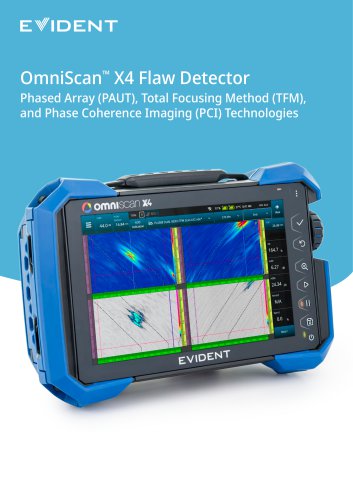 Website:
Evident - Olympus Scientific Solutions
Website:
Evident - Olympus Scientific Solutions
Gruppe: EVIDENT
Katalogauszüge

OLYMPUS■ BTX II, TERRA Your Vision, Our Future Olympus XRD (X-ray Diffraction) instruments come equipped with either a copper (Cu) or cobalt (Co) X-ray tube. For most applications the same performance for compound identification is achieved with either a Cu or Co tube, however, for best results some applications are more suitable for one or the other. Several key factors differentiate between the two X-ray tube options to help determine which X-ray source will give the best performance for a specific application. Clearly distinguishable peaks provide the most accurate compound identification. For some applications with specific sample matrices, the X-ray tube can help in optimizing the diffraction peak-to-noise ratio or the visibility of the diffraction peaks. Microfocus X-ray Tube X-ray Beam Collimator Optimizing Peak-to-Noise Ratio A high peak-to-noise ratio enables accurate identification of the XRD pattern. Two of the phenomena that can affect this ratio are secondary fluorescence and absorption, which occur as a function of the energy of the X-rays and of the major elements composition of the sample. The choice of tube will influence both absorption and secondary fluorescence so it is important to consider these two effects when choosing your tube. For instance, high Fe/Co-containing samples will strongly absorb and fluoresce under Cu radiation, while high Mn/Ti/Ca-containing samples will strongly absorb and fluoresce under Co radiation. Absorption is caused when incoming X-rays get absorbed by the elements in the sample and do not get the chance to diffract. This results in lower diffraction peak intensity and therefore, a lower peak-to-noise ratio. Secondary fluorescence occurs when incoming X-rays excite core electrons from specific elements present in the sample causing increased background and therefore, a lower peak-to-noise ratio. The Olympus Smart Sense filter compensates for this occurrence by filtering out some amount of the counts that have a different energy than the X-ray source although it simultaneously decreases the overall X-ray signal. Iron ore rich in Fe-oxides collected with a Cu source (Red) and Co source (Blue) Mn-oxide collected with a Cu source (Red) and a Co source (Blue)
Katalog auf Seite 1 öffnen
Optimizing Peak Shift The XRD fingerprint is specific to each compound. Some compounds have critical identifying peaks that show up at very low angles or very high angles. The choice of Cu or Co tube has two effects on the peak placement within our detector’s visible range of 5 – 55° 2Θ: shift in the 2Θ range and compression/expansion of the pattern. The right tube choice will result in the optimum shift to see the peaks of interest for a particular substance. A Cu tube compresses the XRD pattern and shifts to low angles as compared to Co. As a result, a wider range of diffraction peaks...
Katalog auf Seite 2 öffnenAlle Kataloge und technischen Broschüren von Evident - Olympus Scientific Solutions
-
IPLEX GX/GT
8 Seiten
-
Mehr Lösungen, mehr Flexibilität
20 Seiten
-
27MG Ultraschalldickenmesser
3 Seiten
-
DELTA Professional
2 Seiten
-
Vanta Overview
2 Seiten
-
IPLEX TX Industrial Videoscopes
4 Seiten
-
OmniScan X4
8 Seiten
-
39DL PLUS
12 Seiten
-
Industrial Light Source Range
4 Seiten
-
35 RDC
2 Seiten
-
Scanners and Accessories
36 Seiten
-
Remote Visual Inspections
16 Seiten
-
OLYMPUS LC30
2 Seiten
-
TRIPLE KIT Generation 2
2 Seiten
-
CIX100
16 Seiten
-
OLYMPUS CIX Series
24 Seiten
-
MX63/MX63L
20 Seiten
-
SWTLU-C
4 Seiten
-
GX53
20 Seiten
-
OLS5000
42 Seiten
-
MagnaFORM
2 Seiten
-
EX Series Instruments
4 Seiten
-
Vanta Overview
3 Seiten
-
Clear Images, Precise Analysis
8 Seiten
-
Portable XRD
2 Seiten
-
TOFD Solution
4 Seiten
-
BondMaster 600
5 Seiten
-
Triple Kit Generation 2
2 Seiten
-
45MG
12 Seiten


































